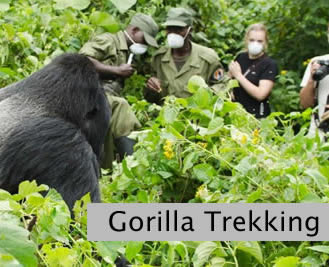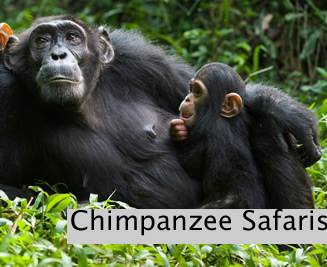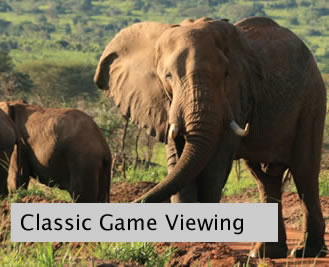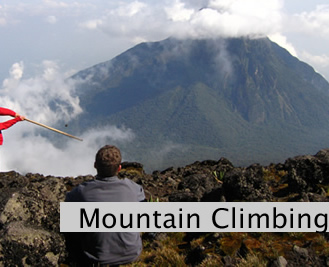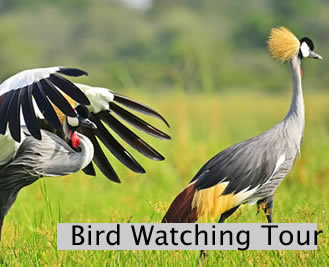Join our 2 Days Uganda gorilla tour to Mgahinga Gorilla National Park with Superfine Safaris. Visit Nyakangyezi gorilla family, the only group in Mgahinga Park. The tour starts and ends in Kigali Rwanda. Mgahinga Gorilla National Park is Uganda’s smallest park spreading over 33.9 square kilometers located in kisoro district in south western Uganda. The small park shelters two of Uganda’s popular primates which are the endangered mountain gorillas and golden monkeys hence the slogans”where silver meets gold”.
Trip Summary
Day 1: Pick up & transfer to Mgahinga Gorilla National Park
Day 2: Gorilla trekking & Departure
Detailed Itinerary
Day 1: Pick up & transfer to Mgahinga Gorilla National Park
 Arrive at Kigali International airport, meet your driver guide from our company and drive via Kigali city to Cyanika Border. Cross over to Kisoro district and drive for roughly 2 hours to reach Mgahinga Gorilla National Park where the silver meets with gold. If time allows, visit the Batwa community villages in the park borders for a cultural performance. Dinner and overnight at Gahinga Lodge, Amajambere Iwacu community Camp
Arrive at Kigali International airport, meet your driver guide from our company and drive via Kigali city to Cyanika Border. Cross over to Kisoro district and drive for roughly 2 hours to reach Mgahinga Gorilla National Park where the silver meets with gold. If time allows, visit the Batwa community villages in the park borders for a cultural performance. Dinner and overnight at Gahinga Lodge, Amajambere Iwacu community Camp
Day 2: Gorilla trekking & Departure
Wake up early, have breakfast, and transfer to Ntebeko Information center for registration and briefing about the rules and regulations of gorilla trekking. At 8:00 am, start off a hike to meet Nyakagyezi gorilla family. Trekking time takes roughly 1 hour to 6 hours depending n where gorillas will be that day and travelers’ physical fitness. On meeting the gorillas, calm down, hold your camera tight and enjoy this magical encounter. Enjoy the human-like characters of gorillas in their families, take as many photos and enjoy this once in a lifetime experience. Hike back, meet your driver-guide and transfer to Kigali airport for your return flight.
End of the tour
Tour Inclusions
• Mountain gorilla family
• Full-time English speaking guide
• Accommodation
• Meals
• Bottled drinking water
• Pick up and transfers
• All activities in the itinerary
Tour Exclusions
• Visa fees
• Personal expenses
• International flights
• Alcoholic beverages
• Tips
• Extra activities not in the itinerary
some people ask
HOW MANY GORILLAS ARE THERE IN MGAHINGA?
As of my last update, Mgahinga Gorilla National Park in Uganda is home to a population of about 10 gorillas. This number can vary slightly due to births, deaths, and migrations, but it gives a general idea of the gorilla population in that park.
HOW MUCH DOES IT COST TO SEE GORILLAS IN UGANDA AND RWANDA?
The cost to see gorillas in Uganda and Rwanda primarily includes the permit fee for gorilla trekking, which is the main expense. Here are the current permit costs (as of my last update):
Uganda
The cost of a gorilla permit in Uganda is $800 USD per person for foreign non-residents.
For foreign residents in East Africa, the permit costs $700 USD per person.
Ugandan citizens pay a reduced fee of 250,000 Uganda shillings.
Rwanda (Volcanoes National Park):
The cost of a gorilla trekking permit in Rwanda is $1,500 USD per person for all visitors (regardless of nationality).
The permit fees contribute to conservation efforts and local communities around the gorilla habitats. It’s important to note that these fees can change, so it’s advisable to check with the respective national park authorities or a trusted tour operator for the most current pricing and availability.
In addition to the permit fees, other costs to consider include transportation to the park, accommodation, meals, and possibly a guided tour if not included in your package.
WHEN TO SEE GORILLAS IN UGANDA
To see gorillas in Uganda, particularly in parks like Bwindi Impenetrable National Park or Mgahinga Gorilla National Park, it’s best to plan your visit during the dry seasons. These typically occur from late December to late February, and from June to September. During these periods, the weather is generally more stable, making trekking conditions easier and reducing the risk of rain which can affect trails and visibility.
It’s important to note that gorilla trekking permits are required and should be obtained well in advance, especially during the peak tourist seasons. Uganda has a limited number of permits available per day to minimize disturbance to the gorillas and their habitat.
Additionally, when planning your visit, consider the conservation guidelines and regulations that protect both the gorillas and visitors. This ensures a safe and sustainable experience for everyone involved.

